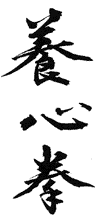| |

Life energy, QI
” Qi ” in Chinese and ” Ki ” in Japanese is the word to describe ” life
energy ” can also be translated as ” air, breath, force, and power ”,
however the above
character is most commonly used to represent the meaning of energy or
vital essence.
According to Chinese belief and medicine, Qi is the animating power
that flows through all living things.
A healthy individual has more qi than one who is ill, a dead person has
no more Qi, the warmth, life Qi is gone. Health is more than a lot of
qi, health means that the Qi in our bodies is clear, rather than
polluted and turbid, and flowing smoothly like a stream, not
blocked or stagnant. Qi is also the life energy one senses in nature.
One of the great contributions of early Chinese culture, going back
thousands of years, was the discovery that it was possible to trace
quite accurately the patterns of energy surrounding all living things,
and in the human body this life energy is circulated through what is
referred to as ”meridians”.
From these studies and analysis came:
1. The foundation for
Traditional Chinese Medicine ( TCM ) including accupressure ( in Japan
known as Shiatsu ), accupuncture, and herbal medicine.
2. Forms or sets of
exercises that strengthen the body internally, stimulating good health,
and long life. ( Nei jia )
3. An effective knowledge
of the anatomy, and the sensitive points, for combat both unarmed and
with weapons known as the Martial Arts.
The ”Qi Network” is like any
transportation system, if there is a blockage at any junction this will
overload the entire system, in the short term this overload can be
compensated in some way, but in the long term serious damage can occur
if not attended to.
In the human body these blockages can be caused by bruising, muscle
injuries, sprains, especially if they are not treated properly, and
quickly.
Long periods of lying, sitting or working in the same position together
with the type of work or nervous tension involved, can also result in
blocking the Qi.The answer to these blockages is ”Qi
Gong” meaning work/training or benefits achieved through regular dedicated effort.
|
|

Qigong
Qi Gong = working with the life energy in developing knowledge and
control of the qi improving the health and harmony of the mind ( Yi ) and
body.
Qi Gong can be divided into two categories :

Dong Gong
Dynamic or active. Yang / exercise
Dynamic Qi Gong

Jing Gong
Tranquil or passive. Yin / meditation
Tranquil Qi Gong
Both these forms of Qigong are
to be found within Yoshinken
through Yiquan ( China ) and Taikiken ( Japan ) and regardless if the
reason for training is for development in the Martial Arts or for good
health and enjoyment, the beginning of every training is the same with :
1. Zhan Zhuang ( Ritsu
Zen ) Standing meditation
2. Shi li ( Yuri ) Slow
arm/hand movements in stationary position
3. Mo ca Bu ( Hai ) Slow
movement forward & back, arms stationary.
4. Zou bu Shili ( Neri )
Slow,flowing arms/hands/legs/body movement
It is advisable to separate these training methods from other training
ways during the same session, as the mind and body need this period to
fully absorb the details in a calm, smooth, and balanced manner.
The
demanding, physical training should be trained at another time, not to
confuse the feelings between soft and hard ( Yin
and Yang ).

|







